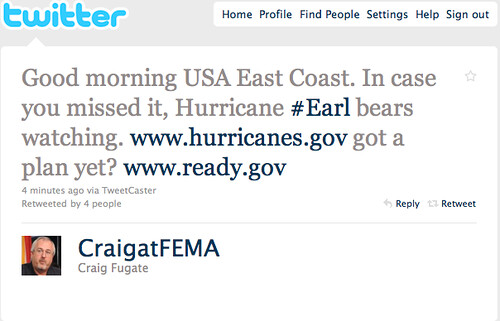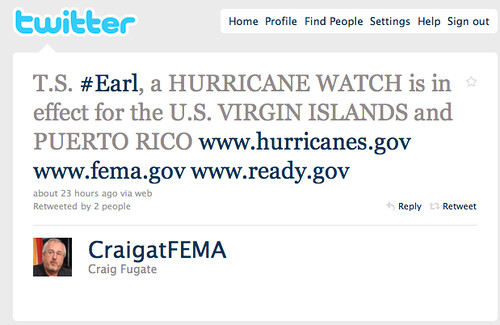Fugate Says FEMA Is Reevaluating Future Of CERT: Significant Changes Possible, Including Offering Mini-Course To More Americans, Significantly Expanding Youth Training: "
In response to a question from the audience at the Red Cross Emergency Social Data Summit last week, Federal Emergency Management Administration (FEMA) Administrator Craig Fugate mentioned that the agency is doing some serious rethinking about the Community Emergency Response Team (CERT) program as it approaches its 25th Anniversary.
The questioner urged Fugate to move CERT from the Department of Homeland Security to FEMA’s jurisdiction. Fugate was able to answer, with smile, “Done,” noting that he now oversees the program which trains citizen teams to assist during emergencies. That answer was easy. However, Fugate knows that determining and then making the necessary changes in CERT to make it most useful for FEMA, local authorities, the citizen volunteers and the nation will not be as simple.
Fugate said that FEMA is considering major changes in the program, including creating a shorter training course which could be offered to more Americans and significantly expanding CERT training for schools and other youth groups in order to better imbed preparedness into society for the long-term.
The CERT program faces a good news/bad news situation, according to Fugate. There are just not enough emergencies in which the civilian teams can take part in. Without activity, it is difficult to keep the citizen volunteers energized, interested and trained.
“Here’s the problem,” he explained, “People say I’ve taken all this training and there are no disasters. Well that’s good thing.” Maybe for the nation as a whole but not for the strength of the CERT program. (The C-SPAN video of Fugate’s speech is here.)
FEMA and local emergency management officials have to answer, in Fugate’s words, “a perennial question we run into: after CERT training, what’s next?”
And more importantly what’s next for the CERT program as a whole?

FEMA Administrator Craig Fugate talks about the CERT program at the Red Cross’ Emergency Social Data Summit on Thursday.
As Fugate correctly diagnoses, there is need for some changes in the program. Right now, in most places there is just not enough work for CERT’s to do. It is a theme that I also hear from members around the nation who contact me through the blog, and I see from my own experience as a CERT here in New York City.
But while CERT teams are not getting enough business, Fugate is bullish about a larger market for preparedness training among the general public.
“We’re looking if there are ways we can take the CERT training and break it up. A lot of [business and social] groups have approached us and said we think this is really great but attention span of our audience won’t get you there. [At present, the CERT training is 20 hours, usually taught over 10 weeks.] But if you could give us 2-4 hours and we could give you our group what could you put together for us in that time that would empower and train people not necessary not to the level of CERT.”
From my experience both serving and reporting on CERT, the idea of spreading its resources out more broadly through the community for adults and kids makes a lot of sense.
One question is how the government should organize this new horizontal model of citizen preparedness training. What should stay under CERT? Should these new ideas (shorter training for adults, kids) be put in another high profile civilian volunteer preparedness or resilience program?
I’ve always felt that CERT training is less about the skills you learn and more about awareness about the community and the various emergency authorities (and identifying citizen crisis organizers in advance). To me, CERT is just basic citizenship training for the 21st Century, which I think every American should get a chance to receive. I might suggest that the smaller reduced curriculum be called something along the lines of “Citizen Resilience Training”.
The overarching philosophy of CERT is terrific: take advantage of citizen’s desire to want to help in crises and their ability to be useful. I believe that interest is even more robust since 9/11, Katrina and with other threats on the horizon. (The rapid growth of the CrisisCommons citizen technology initiative over the past year is just one example of how much public interest there is to assist in emergency situations.)
An extensive survey done by the Citizen Corps (which oversees the CERT program) found that almost two-thirds (64%) of Americans say they would be willing to take a 20-hour training class to assist their community recover from disasters. The 64% figure was striking to me, because it points out an interest of many Americans to become more knowledgeable in emergency preparedness/response. That’s not to say that two-thirds of the population want to join the CERT program, but it does seem to indicate that a lot of Americans would be amenable to some sort of disaster education/training — particularly it was held in their workplace, house of worship, social club, etc.
Now, there are some communities around the U.S. where CERT teams are more fully engaged with activities than others. When I asked readers last month for their thoughts on CERT, Paul Garth from an Ojai, California team said it was up to the members themselves to go out and find things to do, which his group had. To some extent, Garth is right that CERTs themselves should try to develop ideas, but it can also be difficult because they are usually dependent on government emergency officials.
One question is whether the expectations for CERT service be more clearly delineated. There are no ‘cuts’ for anyone who passes the training, and then there are some members who go to every meeting and assignment and others who never show up. It can be difficult to keep a cohesive, engaged group going when some of the team — particularly when it involves sensitive emergency activities — are not fully committed.
It might make sense to have a better-trained CERT civilian group along the lines of another Citizen Corps program, Medical Reserve Corps, which is comprised of volunteer medical personnel. That might make government officials more comfortable in integrating CERT volunteers into its activities like a police auxiliary.
Fugate’s idea of broadening CERT-type training may be most useful when it comes to a younger generation. He believes that if the nation really wants to change social behavior on preparedness it needs to do so with the younger generation — who are not only more impressible than adults but are more likely to influence their parents and will also have a more long-term influence.
It would also be an opportunity to include preparedness into the curriculum in the schools where Fugate believes a culture of preparedness has the best chance of becoming imbedded. One useful historical model is the commitment to school-based fire education after the 1974 publication of the national “America Burning” report. In some cases, youth preparedness/CERT training can piggy back on these existing classroom programs.
Fugate mentioned that there are some excellent CERT programs for young people in parts of the nation. I recently wrote about interesting youth initiatives sponsored by READYColorado and the Colorado Division of Emergency Management, including the creation of a teenage ‘Social Media Response Team’ to help the authorities and the public during disasters. Eastern Michigan University has also taken leadership in developing Teen CERT programs in a number of states

I believe that a decision to expand CERT-type training in the schools would be welcomed on a bipartisan basis. In an interview I did with former Bush Administration Homeland Security Secretary Michael Chertoff last year he agreed that a key to creating a long-term prepared nation is to focus on schools and kids. In the discussion, he sketched out two suggestions – a “minimum” and a “maximum” approach. The “minimum” would be “to get the fire management and emergency management people to come together to create a program to be exported to the schools on basic preparation.”
Chertoff’s “maximum” option is that there be a more substantive course developed for U.S. schools on planning and preparation, which would include teaching “basic skills”. It would almost serve as a very limited albeit useful national basic training.
“If you’re not going to have a national service then as part of graduation from high school there should be a course over a period of time that teaches you the kind of basic things you might need in an emergency,” Chertoff says, adding “It’s going to do two things. It’s going to create a cadre of more capable people, but it is also going to demystify the process of preparation. Most people are intimidated that they don’t know how to do it. They’re afraid of being embarrassed.”
As FEMA officials examine what to do with CERT going forward, I imagine they will be undertaking an analysis of the future need and demand. Though it is a very well-intentioned idea — and I have really enjoyed and learned from my CERT work — there may well be that there a limit to what moderately trained part-time volunteers can really do in the official emergency services world. Maybe the bulk of CERT volunteers who are willing to commit just to the basic training and limited participation would be better to be transferred to the disaster services unit of Red Cross chapters from around the U.S.. which is busier with fires and local emergencies.
I recommend that FEMA should also reach out to some CERT team leaders/members in communities around the U.S. as government officials do not always know what is going on within the CERT teams (as this blog post from state emergency management official Mark Chubb underscores).
To me, civilian CERT members can best serve the community by being, in Fugate’s words, preparedness “ambassadors” providing information and guidance to their neighbors. When it comes to citizen preparedness, there is a real need for explanation and modeling, and CERT members can be hugely helpful in part as emergency management offices don’t always have the time always the inclination to do so. Further, the growth of social media platforms underscore the value of friend-to-friend, peer-to-peer education both before and during emergencies.
I received a thoughtful e-mail last year from the State of Florida’s former CERT coordinator Bill Firestone who served under Fugate in which he elaborates on the value of the “ambassador” role.
While it’s very unlikely that most CERTers will participate in a mass casualty triage or perform in pairs in fire suppression, CERTers will talk to their neighbor, participate in their children’s schools, attend neighborhood activities. Consequently, they can reach out to people that government and non-profit preparedness messages cannot reach or it is too expensive.
In my role as a “CERTer”, here in Florida, I am reaching out to neighbors and talking to them about the network of non-profits in disaster and the importance of knowing what services and assistance they can provide before and after disaster. Here in hurricane-prone Florida I have begun to send along the url for information about the importance of completing an SBA loan application and how that is tied to receiving additional disaster assistance. Most of my neighbors that have incurred damages to their house have been told about the low-interest loans following disaster, but not aware of the other benefits to completing the application.
If you have any thoughts on FEMA’s reevaluation of CERT, I’d love to hear them.

Handing out preparedness information at a Manhattan street fair with my own youth CERT in training.

"









